Prettyfields Vineyard: Great wine “starts with the vine”
22nd March 2023
Rooted firmly in the Essex countryside, owner Robert Blyth says Prettyfields Vineyard harnesses the local microclimate to “grow the finest grapes and put the very best into our bottles”. Editor Rachel Hicks chatted with him this month.
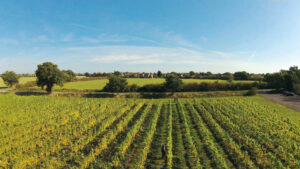
Grower profile:
- Total vineyard size: 7ha, with 4ha under vine
- Soil type: Light sandy loam in good, free-draining land
- Aspect: The vines are planted east to west; the land gradually drops away to the west and the vineyard is roughly 100ft above sea-level. Typical wind is from the south west. There is a micro climate caused by Ardleigh Reservoir which reduces frost in the late spring. As the crow flies, the vineyard is located around five miles from the sea
- Varieties: Pinot Noir, Pinot Meunier, Chardonnay, Bacchus
Robert Blyth is a partner and farm manager of Blyth Farms in Ardleigh, with his sister Rosie and his father James having owned the land since the 1960s.
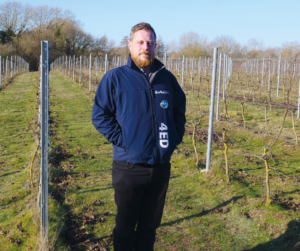
The Blyth family also farms at Brightlingsea, near to the Thorrington Mill Vineyard. Previously, Robert’s father had used the services of contracting company Sentry Farms for 25 years or so, but has more recently brought the land back into the control of the family.
Part of the farm’s vista changed drastically in the 70s with the construction of nearby Ardleigh Reservoir, and this is one of the factors which led to the farming enterprise taking the decision to plant the vineyard as an investment in 2016.
Three varieties were planted at that time – Pinot Noir (four acres), Chardonnay (three acres) and a small amount of Bacchus, with three acres of Pinot Meunier being added later in 2019.
While most of the fruit is used for Prettyfields’ own wine, some of the Chardonnay grapes are grown on contract for Hattingley Valley to be used in their Blanc de Blancs, with Hattingley commenting that the Prettyfields Chardonnay offers an unusually tropical aroma compared to the more citrussy Chardonnay juice which they get from the Sussex vineyards who supply them.
Prettyfields also buys in grapes from other vineyards in order to be able to expand their range. There are loose plans to extend the vineyard with the planting of some more varieties in the future.
Keeping it in the family
Robert and his sister Rosie worked with their second cousin, Tom Bunting, at another local vineyard in Dedham years ago, and Tom set up his own vineyard management company, TBVM, as a result. This has proved invaluable to Robert, as he now employs the services of TBVM to manage much of the specialist work required on the vineyard, allowing him the time throughout the year to focus on the farming enterprise, so both operations can run successfully in tandem despite the pressures and difference in pace. TBVM provides the majority of the machinery needed on a contract basis, as well as managing the spray programme and giving general agronomy advice.
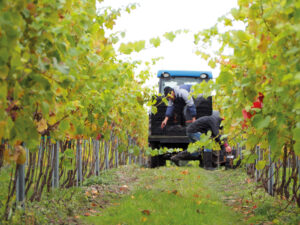
A very local harvest
First harvest in 2019 was fairly limited due to the age of the vines, but yield has increased consistently year-on-year.
While Prettyfields produced a respectable 10,000 or so bottles last year, the searing heat and drought of 2022 did have a significant effect – the vineyard had been given high yield predictions pre-drought, but at the time there was uncertainty around whether you could water the vines. The vineyard follows the French guidelines which state that if you’re taking fruit off the vine to make wine of a quality wine status then you are not allowed to irrigate after 1st May – although Defra has since announced that growers can irrigate the vines.
As such, in preparation for this coming season, Robert has adapted an irrigator previously used on the arable farm for potatoes, cutting the trolley down so it can fit up the rows pulled by an old Massey Ferguson 135 vineyard tractor that he has borrowed from his uncle, who is a vintage tractor collector.
Underground irrigation pipes have also been added to the parts of the vineyard that previously lacked them.
This year, the hope is for a harvest of around 20t in total, as long as conditions are right. While he is happy with the varieties which are currently grown, Robert feels the vineyard perhaps should have opted for a rootstock that was better suited to drought, being on a light, sandy soil; but at the time, they went with the one that was recommended by the nursery in Germany, and with the new irrigation system in place, Robert
has high hopes for this season.
Managing frost risk
Another key challenge for Prettyfields is late frost. The vines closest to the reservoir are protected somewhat by the microclimate provided by the water, but the Chardonnay in particular, which is situated furthest from the reservoir, is at a much higher risk of late frost damage.
Robert hopes that the government will offer some grants for frost protection equipment in the near future, but the frost fans that were put forward in the last round of grants weren’t the right ones for vineyards, making the investment too cost-prohibitive.
Robert has looked at candles as an option, but they are so labour intensive, and with the vineyard taking regular stalls at local farmer’s markets, sleepless nights spent lighting candles are out of the question.
One method currently being trialled on the Chardonnay is a different style of pruning – leaving two canes, with one cane up as a sacrificial one which should draw any frost up away from the cropping cane. This is then pruned off once the frost risk has passed.
Across the vineyard, the trellising used is the single Guyot system, with a mixture of wooden and metal end posts.
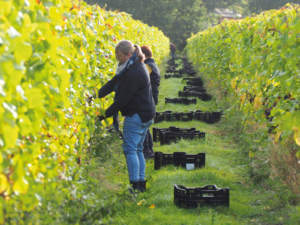
Pest and disease management
Prettyfields follows a fortnightly spray programme which is continuously monitored by TBVM. They use a flying black bird-shaped kite to deter birds, as well as rope bangers.
Robert explains that that part of Essex tends to record a much lower rainfall compared to the rest of the country, therefore disease pressure is low.
The Pinot Noir can suffer from botrytis, but they manage to keep on top of this fairly easily with good canopy management.
Vine prunings have been burnt in the farm’s biomass boiler previously, but handling of the prunings can be difficult. Over the last couple of years, the vineyard has been mulching the healthy prunings back into the soil, which they do for the soil benefits and will continue to do so all the while the vines remain disease-free.
Robert has considered chipping some of the prunings for use in a smoker, but for now prefers to put the organic matter back into the soil.
Soil is tested annually, and it appears to be consistently good on its P and K. Robert has discussed bringing in livestock for both the manure as well as the natural help provided for weed control, canopy management and so on. He believes it’s much better to rely on natural processes where possible, and feels it’s an important part of the sustainability of the vineyard.
In a similar sustainability vein, the vineyard uses local labour, as well as stocking local produce in the farm shop as much as possible.
At harvest time, up to 80 people arrive from the nearby village to pick the grapes on a volunteer basis – although they also get to enjoy a coffee, cake, lunch and a voucher to use in the shop as a thank you. Last year, they were treated to a delicious paella which was received particularly well.
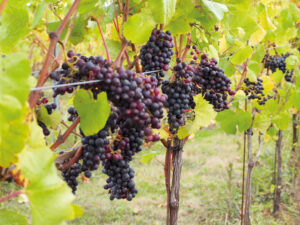
Milder winters have an effect
Bud burst occurs around mid-April; this used to happen later, but with the milder winters it’s been pushed forward.
The vineyard undertakes the usual summer pruning, which is very important for air flow and helps put energy into the grapes throughout late May/June. Sometimes they have double buds, which they take down to a single fruit on the fruiting cane. Flowering occurs early July, then they leaf strip.
Veraison is early to mid-August, and the Chardonnay is harvested first, at the end of September/early October, followed by the Bacchus before moving on to the red grapes.
Expert wine makers
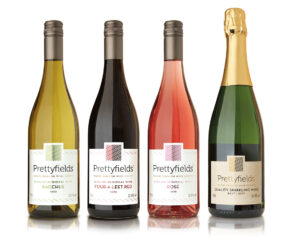
Using an off-site winery, Robert says, has allowed them to use expert wine makers to produce excellent drinking wines.
However, keen to bring the full production onsite in the long-term, he has been discussing options with a local commercial co-operative winery who were booked in to visit the site in the week following Fruit & Vine’s interview, so watch this space.
Robert feels though that while wine production is starting to really push towards sustainable management, packaging options such as cans are not yet commercially viable, as consumers are only recently coming around to the quality of English wines and it’s only just finding its place in the market, so this isn’t something Prettyfields would consider for now.
Local marketing key
The bulk of Prettyfields’ wines are sold locally, via the onsite farm shop and vineyard tours and special events which are run by Skylark Social, as well as through local shops and restaurants.
Marketing is done very much by social media as well as word of mouth from the many happy customers.
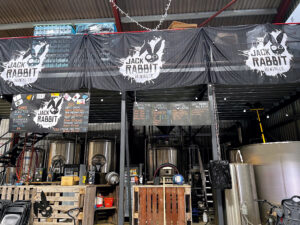
Future plans for the vineyard
Robert’s future plans are to continue to focus on the wine tourism sector of the business. As well as the vineyard’s farm shop, Prettyfields Tours, tastings and lunch, there’s a brewery based onsite – Jack Rabbit – which brews ales, stouts and lagers as well as offering niche cocktails.
Since opening, Prettyfields has hosted a few fun and diverse events which proved incredibly popular, including the slightly sinister-sounding ‘axes in the vines’, and they intend to expand upon the diversification side.
With a beautiful church located just down the road, the site has also hosted a couple of very successful wedding receptions, with more booked in over the next year.
